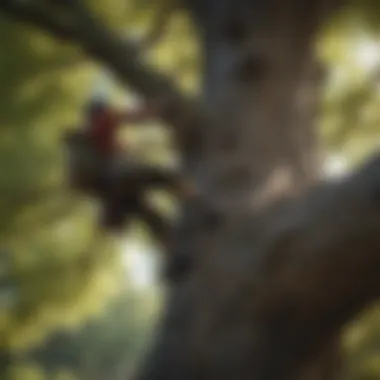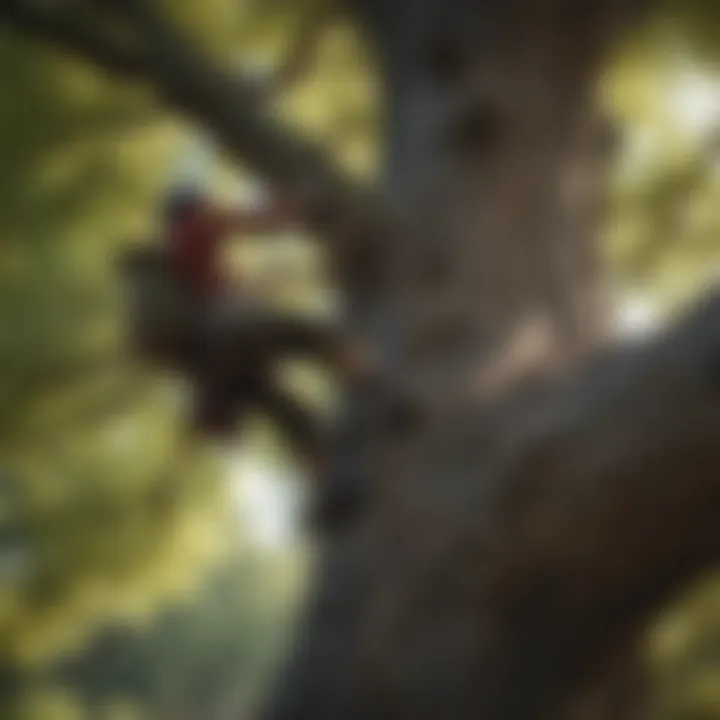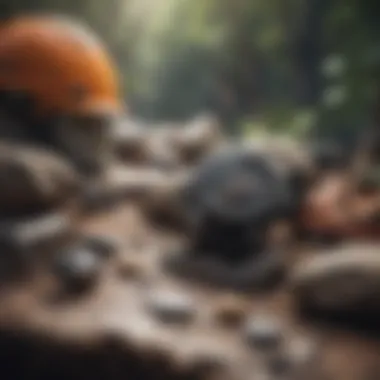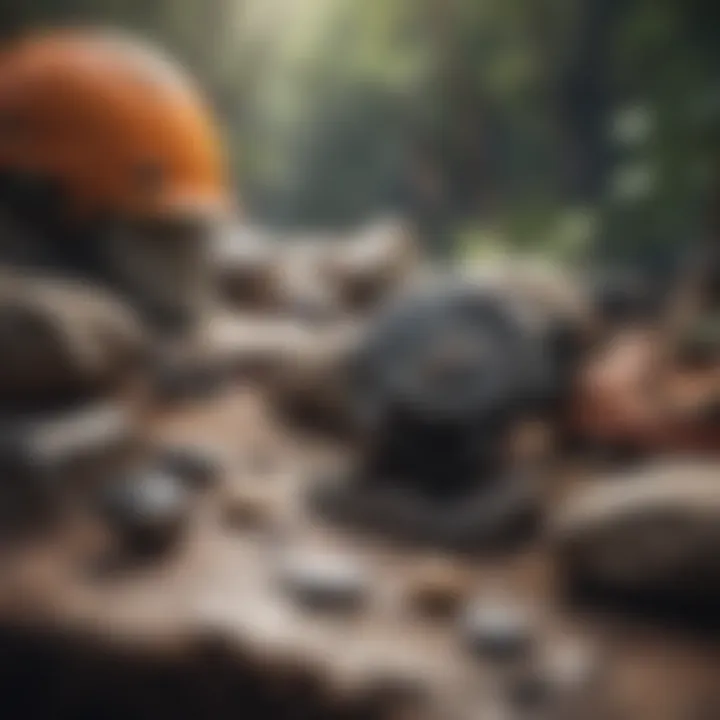Mastering the Art of Tree Climbing Safely and Effectively


Intro
Tree climbing, a pursuit that dances between thrill and serenity, is an art form that beckons to a diverse group of adventurers. Whether you find yourself scaling the towering pines of the Pacific Northwest, or embracing the gnarled branches of ancient oaks, understanding the craft is essential not only for enjoyment but also for safety. Reaching new heights allows you to escape the ordinary and connect with nature in an unmatched way. This guide seeks to equip you with the necessary skills, insights, and preparations to master tree climbing.
When considering tree climbing, it’s not just about getting to the top; rather, it's about the journey, the methods employed, and the surroundings. It’s easy to underestimate the intricacies involved in ascending a tree. Techniques can vary widely based on tree species, local climates, and personal experience. For those afraid of falling or hesitant to leave solid ground, fear not! With the right mindset and a set of reliable practices, you’ll find that tree climbing becomes more about technique than about common daring.
In delving deeper, our exploration will break down effective climbing techniques, the essential gear you’ll need, and the critical safety measures to keep in mind. As we embark on this journey, don’t forget that becoming a skilled climber takes time and patience. It’s not a race but rather a gradual ascent towards expertise—one branch at a time.
"The best view comes after the hardest climb."
Let’s leap into the core methods and tips to set you on the right path.
Techniques and Tips
Skill Development
To tackle tree climbing like a champ, developing foundational skills is key. Start with understanding basic techniques such as grip strength, balance, and body positioning. Joining a local climbing group or taking classes can accelerate your journey.
Consider integrating exercises that enhance your core strength and flexibility. Practices like yoga or bodyweight workouts can contribute mightily to your climbing prowess. Plus, do not shy away from climbing smaller trees first to hone your skills before attempting the giants. The transition from one to the other isn’t always an easy leap, but it’s a necessary step.
Practical Techniques
Different trees require unique approaches, but here are some practical techniques to consider:
- Three points of contact: Always keep three limbs in contact with the tree, which creates balance and stability as you ascend. This is crucial.
- Use of a harness: Harnesses offer a level of security that’s hard to beat. Invest in a decent one.
- Branch Selection: Choose branches that can safely support your weight. Test them before committing your full weight.
- Footwork matters: Push down through your feet to exert force upwards. This reduces strain on your arms.
Common Mistakes to Avoid
Often, climbers fall into pitfalls that can easily be avoided:
- Rushing: Take your time while ascending. Falling can happen in the blink of an eye—slow and steady wins the race mostly applies here.
- Ignoring Gear Maintenance: Make sure your gear is in tip-top shape. Frayed ropes or rusty carabiners don’t inspire confidence.
- Climbing Alone: It’s always safer to climb with others. In the event of a mishap, backup support is invaluable.
Gear and Equipment
Essential Gear for Beginners
For those just starting, a reliable set of gear can enhance your experience and safety. Here’s a list that should cover the basics:
- Climbing Harness: Ensure it fits well and is comfortable.
- Helmet: Protect that noggin! Always wear a protective helmet.
- Climbing Rope: Opt for dynamic ropes as they absorb the shock during falls.
- Carabiners: Choose locking carabiners to avoid accidental opening.
Latest Innovations and Trends
In recent years, climbing gear has evolved significantly. New materials and designs have made equipment lighter and stronger. Brands like Petzl and Black Diamond lead the charge with innovations focused on safety and usability. Stay updated by following reputable outdoor gear review sites and community forums.
Reviews and Comparisons
Before investing in gear, consider diving into reviews. Websites such as Reddit’s r/climbing or climber’s blogs often provide insights that can help you make more informed decisions about what to buy.
Safety Measures
Essential Safety Gear
Safety gear cannot be stressed enough. Along with a harness and helmet, consider additional items:
- Rope Bag: Easy transport for your climbing ropes and gear.
- First Aid Kit: Because you never know when a scratch may occur.
- Basic Climbing Guide: Having information at hand can be invaluable.
Best Practices for Safe Participation
Safe participation in tree climbing extends beyond just having gear. Always do a proper assessment of the tree and environment. Check wind conditions and weather forecasts before climbing. And remember, being aware of your surroundings while up in the branches matters greatly.
Injury Prevention and Management
Injuries can indeed happen, but the right practices can minimize risks. Warm-up exercises prior to climbing will get your muscles ready. Moreover, ensuring you have a basic understanding of how to treat common injuries like falls or bruises can be incredibly helpful.
Finale
So, as we wrap up, keep in mind that tree climbing is less a reckless endeavor and more an engaging art form requiring skill, awareness, and practice. With the right knowledge, tools, and mindset, anyone can ascend to new heights and experience the world from a fresh perspective.
Now, with the groundwork laid, it’s time to lace up those climbing shoes, shoulder the gear, and hit the trees!
Preface to Tree Climbing
Tree climbing, often seen as an adventure or hobby, opens up a world of possibilities and insights into nature that few activities can offer. Understanding tree climbing goes beyond just ascending branches; it's about connecting with the environment, embracing challenges, and exploring heights that many overlook. For those thrill-seekers and adventure lovers, tree climbing provides not only the rush of reaching new heights but also a unique perspective on nature's beauty.
Climbing trees is a practice steeped in history and culture, showcasing humanity's long-standing relationship with trees. It can be as simple as a child's play or as complex as an athletic endeavor. The benefits are multifaceted: it encourages physical prowess, enhances mental clarity, and engages social bonds through community climbing activities.
Before diving into the complexities of climbing techniques and safety gear, one must appreciate the rich backdrop against which this exhilarating hobby unfolds. Tree climbing enhances one’s skills in movement, requires comprehensive understanding of nature, and fosters appreciation for ecosystems—every climber becomes a part of this age-old tradition. Thus, this section sets the stage for discussing not only the techniques but the underlying principles shared by climbers around the world.
Historical Background
The tradition of climbing trees is ancient. From the times of early humans, who climbed trees for food and shelter, to modern climbers utilizing advanced techniques and tools, the art of climbing trees has evolved significantly. In certain cultures, tree climbing was not merely a physical endeavor, but a rite of passage. For example, in some native tribes, young men would learn tree climbing skills as part of their training for hunting or other essential community activities. The skills learned weren’t just practical but imparted essential values such as bravery and respect for nature.


In more recent history, tree climbing became popular among outdoor enthusiasts and extreme sports communities. The introduction of climbing gear in the 20th century revolutionized the practice, making it safer and more accessible. People began to not only appreciate the thrill of ascending trees but also the skill involved in navigating various tree types. As the cultural significance of tree climbing grew, clubs and organizations began forming, creating communities around this shared passion.
Cultural Significance and Uses
Tree climbing holds cultural significance that varies from region to region. In some places, tree climbing is essential for gathering fruits or nuts. For instance, in the coconut-producing regions, local harvesters are acclaimed for their speed and prowess in climbing palm trees to collect coconuts. Similarly, certain areas rely on climbers to maintain high-altitude orchards or to conduct ecological studies by reaching the canopy.
Moreover, the communal aspect of tree climbing has flourished. Groups of climbers share techniques, stories, and experiences, enhancing their skills through camaraderie. The act of climbing connects people to each other and their environment, fostering a sense of community that transcends differences. Events, competitions, and gatherings centered around tree climbing allow enthusiasts to bond while showcasing their talents.
Understanding Tree Anatomy
Grasping the essentials of tree anatomy is fundamental for anyone interested in the art of tree climbing. Trees come in various shapes and sizes, and each type bears unique features that can either aid or hinder your climb. By familiarizing yourself with how trees are structured, you gain insight into which elements provide stability and support, thus enabling a safer and more efficient climbing experience.
Tree anatomy isn't just about the leaves and bark; it's a detailed examination of the interrelated parts that work together to form a complete organism. Knowing how each part functions can help climbers make informed decisions about their climbing routes and techniques.
Parts of a Tree Relevant to Climbing
Trunk Structure
The trunk of a tree is more than just a tall pole; it serves as the backbone of the tree, connecting the roots to the branches and leaves. A strong trunk supports the weight of the branches while providing an anchor point for climbers. Trees with thicker, rugged trunks are often more appealing for climbing due to their stability.
Another vital aspect of trunk structure is its bark. Trees like oaks or maples have rough textures that can help with grip, unlike smoother-trunked varieties like birches. A rough bark can feel reassuring when you're several feet off the ground, making it a favored characteristic for climbers looking for a sturdy surface. However, it's worth noting that not all trunks are created equal; some can suffer from rot, so a visual inspection is essential for safety.
Branches and Canopies
The branches and canopies of trees are where much of the climbing action takes place. Well-spread branches can offer excellent handholds and footholds, allowing the climber to maneuver upward with ease. A strong canopy can create a shaded, cool environment, providing relief during a long climb.
A significant feature here is the canopy's density—the denser the canopy, the more challenging it can be to navigate. However, a lush canopy also offers shelter from rain and sun, adding to the overall experience. Climbing a tree with a sparse canopy can be exhilarating but may expose you to harsh weather, making it essential to choose wisely when selecting your climbing target.
Root Systems
Roots are often overlooked in climbing discussions, but they are critical for understanding a tree's overall stability. A well-developed root system allows trees to withstand strong winds and provides the necessary support for the entire structure above ground. Knowledge about a tree's roots can be beneficial for planning climbs, especially when seeking trees that can handle the weight of a climber without risk.
Additionally, different species have varying root structures. Shallow roots may be indicative of a tree that could be toppled by strong winds, while deeper roots often imply a more stable tree. This understanding can aid climbers in their decision-making and risk assessment, ensuring their climbing endeavors are rooted in safety as well as skill.
Tree Species and Their Climbability
Softwood versus Hardwood Trees
When comparing softwood to hardwood trees, each has its own climbing characteristics and advantages. Softwood species like pine often provide a lightweight option for climbers. Their straight trunks and flexible branches can be appealing, especially for those seeking a straightforward climb. However, softer woods may suffer from less durability over time, which could lead to unexpected breaks during a climb.
On the other hand, hardwoods such as oak or maple are sturdier and provide excellent grip, but they can be heavier and might require more effort when climbing. Hardwoods typically offer more substantial branches and roots, contributing to a safer climbing experience. Thus, the choice between softwood and hardwood should hinge on the specific climbing goals and personal preferences of the climber.
Common Climbing Trees
Many trees are particularly sought after for climbing, and knowing the common types can enhance the climbing experience. Trees such as the maple, oak, and ash are often recommended due to their sturdy branches and reliable trunk structures. These trees not only provide a safe climbing experience, but they also invite climbers to enjoy a scenic view from above, making the effort all the more rewarding.
It’s also important to note that climbers should be aware of the local environment; certain regions may feature species that are particularly good for climbing, while others might have trees that are less friendly to climbers.
Preparing for a Climb
Preparing for a climb is as vital as the ascent itself. It sets the stage for not only physical readiness but also mental acuity. When one considers the nuances of tree climbing, it becomes clear that preparation can make the difference between a safe climb and a precarious situation. Without adequate preparation, even the most seasoned climber can find themselves in trouble, whether it’s from fatigue or unexpected challenges in the environment. This section dives into the multifaceted approach required for preparing for a climb, integrating physical conditioning, mental preparation, and gear selection into an effective strategy.
Physical Conditioning and Skills
Strength Training
Strength training plays a foundational role in tree climbing. It equips the body with the muscle power necessary to hoist oneself up sturdy branches and navigate challenging trunk structures. The key characteristic of strength training in this context is its emphasis on functional movements. Instead of simply bulking up on weights, climbers benefit from exercises that mimic climbing itself, such as pull-ups and hangs. This not only builds the right muscles but also improves grip strength, essential for a secure hold on branches.
A unique feature of strength training is its adaptability. Climbers can tailor their routines to target specific muscle groups crucial for climbing. However, one has to be cautious; overtraining can lead to injuries. Therefore, strength training requires a balanced approach to prevent burnout while still enhancing climbing performance.
Flexibility Exercises
Flexibility exercises are equally important in the overall preparation process. The ability to stretch and extend one’s limbs can significantly ease climbing movements, reducing the risk of strains or sprains. The great thing about flexibility is that it enhances one’s range of motion; this means easier reaches and more fluid movements up the tree.
Certain stretching routines, like yoga or dynamic stretches, are particularly beneficial. These exercises not only increase flexibility but also enhance balance and coordination. Ultimately, flexibility exercises promote injury prevention, allowing climbers to maneuver gracefully through the tree canopy. Yet, it’s important to not push flexibility too hard, as overstretching can lead to other issues.
Mental Preparation
Focus and Mindset
Mental preparation is often underestimated, but it can be a game-changer. A focused mindset before the climb can dictate how one responds to challenges during the ascent. Here, the key characteristic of mental preparation is its emphasis on clarity and calmness. Climbers need to cultivate a mindset that not only anticipates challenges but embraces them.
Visualizing potential obstacles and navigating through them in one's mind fosters confidence. This mental rehearsal can be powerful, turning anxiety into excitement. It’s important to remember that a hurried mind can lead to mistakes, so taking a moment to breathe and center oneself before climbing can enhance focus. However, balancing focus with relaxation is crucial; a rigid mind can be just as harmful as a distracted one.
Visualizing Climbing Routes
Visualizing climbing routes can elevate a climber’s approach to tree climbing significantly. When climbers mentally picture their ascent, breaking it down into manageable sections, they often perform better and minimize mistakes. This technique allows climbers to familiarize themselves with the obstacles and branches they will encounter, streamlining their path.
The unique feature of this visualization technique lies in its cognitive nature. It activates the mind's ability to foresee challenges and prepare for them. By mentally discussing potential routes and strategies beforehand, climbers find themselves more equipped to tackle the journey. However, there’s a caveat: focusing too much on visualization can lead to a fixation on potential pitfalls, creating unintended anxiety.
Gear Selection
Climbing Shoes


Climbing shoes are often seen as the climber's best friend, critical for establishing footholds and moving with confidence. The key characteristic of climbing shoes is their design, which allows for optimal fit and flexibility. Well-fitted shoes enhance grip on branches, giving climbers the traction needed to ascend securely.
The unique advantage of climbing shoes is their sole material, typically made from rubber, ensuring maximum grip. However, a downside is that they may not offer the same comfort for long periods. Choosing the right pair for specific climbing conditions is essential, as the wrong fit can lead to fatigue long before reaching the top.
Harnesses and Ropes
Harnesses and ropes are pivotal tools in tree climbing, offering essential safety measures. A harness secures the climber, connecting them to safety ropes that can arrest a fall. The major characteristic of these tools is their reliability and durability; they need to withstand significant weight and stress.
What sets this gear apart is its versatility. Climbers can use various harness types designed for the specific style of climbing they intend to do. On the downside, improper use of ropes or harnesses can lead to disasters. Thus, ensuring proper fitting and understanding their usage is critical.
Safety Equipment
Safety equipment encompasses a range of tools that serve as the last line of defense against accidents. This includes helmets, first aid kits, and other protective gear. The key characteristic of safety equipment is its foundational role in risk management; climbing without safety gear is like driving without a seatbelt.
The unique feature of this type of gear is that it can protect against the unexpected, such as falling branches or accidental slips. The advantages of having robust safety measures far outweigh the perception of them being cumbersome. But, it’s essential to categorize safety equipment based on specific climbing activities, as different climbs will present unique risks and requirements.
"Climbing involves risks, but with proper preparation and gear, these risks can be significantly minimized, allowing climbers to focus on the adventure, not just the ascent."
By strategically preparing for a climb through physical conditioning, mental fortitude, and careful gear selection, climbers not only enhance their skills but also their overall experience in the treetops.
Techniques for Climbing
Climbing trees isn’t just about having guts and grabbing hold of branches. It’s about knowing the tricks of the trade that separate the amateurs from the pros. Techniques for climbing are vital because they encompass the methods that ensure both efficiency and safety as you scale to new heights. Utilizing the right climbing techniques significantly boosts one's confidence and ability to navigate complex tree structures, ultimately transforming how one interacts with nature in an adventurous manner.
Basic Climbing Techniques
Foot Placement and Grip
Foot placement and grip are fundamental aspects that set the groundwork for any tree climbing experience. The strength and stability of your foothold play a crucial role, as they influence your balance, agility, and overall climbing efficiency. A key characteristic of effective foot placement is precision. Placing feet accurately can prevent slips, falls, and exhaustion, making it a sound choice for anyone looking to climb with confidence.
What's unique about foot placement and grip is the emphasis on using the natural contours and features of the tree. For example, saplings have their own particularities; understanding how to utilize knots and protrusions aids in generating stable support. The advantage of mastering this technique is not only increased safety but also the ability to ascend quickly. However, a disadvantage might arise if a climber becomes too focused on perfecting placement, leading to overthinking and hesitation while under pressure.
Body Positioning
Body positioning relates directly to your center of gravity and how it shifts as you climb. Maintaining an optimal body position allows for better balance and a more fluid climbing motion. A key characteristic of proficient body positioning involves keeping one's body low and close to the trunk, maximizing stability while minimizing the effort required to hold onto branches.
The unique feature of body positioning is that it changes depending on the type of tree and the specific climbing route. For example, the limbs of a pine tree may demand more outward balancing poses, whereas hardwoods often require a more upright stance. The advantages here are clear: maintaining a low center of gravity reduces the risk of falling. Nevertheless, a notable downside is that climbers might find certain positions uncomfortable, leading to fatigue over extended climbs.
Advanced Climbing Techniques
Using Climbing Gear
When ascending into the canopy, knowing how to effectively utilize climbing gear is indispensable. Climbing gear enhances safety and efficiency, allowing climbers to explore higher branches without the fear of losing grip. A key characteristic of climbing gear is its ability to distribute weight and prevent falls. This aspect is especially beneficial for those who wish to explore the vertical world of trees without constant worry.
The unique feature of using climbing gear lies in their specialized designs, including harnesses that create a secure connection point and ropes that can absorb shock. The advantages are immense, as these tools provide a safety net that encourages more adventurous climbs. However, relying too heavily on gear can sometimes lead to complacency in using one's innate skills, making it essential for climbers to blend gear use with natural climbing abilities.
Dynamic Movement Strategies
Dynamic movement strategies can make the difference between a routine climb and an exhilarating experience. This technique involves using momentum and fluidity to navigate the tree rather than relying strictly on brute strength. Key to these strategies is the ability to flow between movements, thereby maintaining speed and minimizing exhaustion.
The unique feature of dynamic movement strategies is their application during more complex climbs where quick changes in position are necessary. These strategies encourage climbers to engage their whole body, fostering not just strength but also coordination and control. On the flip side, the downside might be that novice climbers could find these techniques challenging to master, which can discourage them from even attempting advanced climbs.
"Effective climbing strategies integrate both traditional techniques and innovative movements, leading to a safer and more enjoyable experience in the trees."
With this in mind, both basic and advanced climbing techniques offer a wealth of knowledge for both novices and experienced climbers to maximize their experiences among the trees. Knowing when and how to employ these techniques can lead to personal breakthroughs and deeper connections with nature.
Safety Measures and Considerations
Safety in tree climbing is paramount, cutting across various dimensions of the activity. Engaging in tree climbing without a firm grasp on safety measures can lead to severe consequences, not just for the climber but also for the ecosystem. Specifically, understanding and implementing safety measures can mean the difference between a thrilling adventure and a life-altering disaster.
Climbers must lay the groundwork by thoroughly assessing risks before ascending any tree. This article will delve into crucial components in the realm of safety, emphasizing risk assessments and protocols to follow in emergencies.
Pre-Climb Risk Assessment
Before embarking on any climb, conducting a thorough risk assessment is not just advisable – it’s a necessity. Climbing a tree without knowing what lurks below or around can be climbing into a hornet’s nest of potential dangers. Here’s a closer look at the two major facets of the pre-climb assessment.
Environmental Assessment
Environmental assessments consist of evaluating the area around the climbing site. This involves identifying potential hazards such as loose branches, animal habitats, and unstable soil. Key in this assessment is understanding the local flora, as different species can harbor threats or offer unique advantages.
For example, a well-established oak might provide sturdy branches but could also house wasp nests or be a breeding ground for beetles that weaken the wood. In this case, knowing your environment allows climbers to either adjust their approach or choose a different tree altogether.
The unique advantage of an environmental assessment lies in its proactive nature, enabling climbers to avoid hazards before even starting. However, a significant disadvantage may arise when climbers lack familiarity with local species, leading to misinterpretations of safety. Thus, awareness and knowledge become essential.
Weather Conditions
Weather conditions are another critical aspect to assess before climbing. Strong winds, rain, or rapidly changing temperatures can all impact the safety of a climb. Wind can sway branches unpredictably, rain can make surfaces slippery, and temperature swings can affect how a climber’s body reacts during exertion.
A key characteristic of weather assessment is its dynamism; conditions can shift from calm to tumultuous with little warning. For climbers, staying updated on local forecasts and being prepared to make swift decisions based on weather changes is crucial.
One unique feature of managing weather conditions is that climbers can leverage apps or resources that provide real-time updates, allowing for informed choices about when to climb. However, these tools come with their own set of disadvantages, such as over-reliance leading to complacency. It’s wise to remember that technology should aid, not replace cautious judgment.


Emergency Protocols
Even with rigorous safety measures in place, accidents can and do happen. Establishing emergency protocols can put climbers in a better position to respond swiftly and effectively when things go awry. We will explore two primary elements of emergency protocols: fall prevention and first aid considerations.
Fall Prevention
Fall prevention mechanisms are essential in any climbing scenario. They range from using high-quality harnesses and ropes to employing climbing techniques that minimize risk. A key feature of fall prevention revolves around equipment reliability; ensuring that gear is well-maintained and suited for the specific type of climbing.
The benefit of prioritizing fall prevention is significant – it can substantially reduce the likelihood of serious injuries. For instance, using a double figure-eight knot ensures that, even if the climber slips or loses grip, the connection is as secure as can be.
However, there is a notable disadvantage—overconfidence in safety gear can lead climbers to take unnecessary risks, thinking they are invulnerable. It’s critical to maintain a balance between using equipment effectively and understanding its limits.
First Aid Considerations
Understanding first aid is a vital aspect of climbing safety. It’s not enough to just prevent accidents; climbers must be ready to handle any injuries that may occur. Knowledge of first aid can dramatically improve outcomes and provide peace of mind during more hazardous climbs.
A key characteristic of first aid considerations is accessibility; having a first aid kit handy and ensuring all climbers know its contents can make all the difference in an emergency. Equipped with bandages, antiseptics, and even splints, a well-stocked kit can turn a potential crisis into a manageable situation.
That said, the downside lies in assuming that having a kit is sufficient. First aid knowledge must be ingrained and practiced; it’s not just about having tools but also knowing when and how to use them effectively.
In summary, mastering tree climbing is not just about reaching the top. It’s about being thoroughly prepared and aware of both safety measures and emergency protocols.
In navigating the world of tree climbing, blending skill with safety will equip thrill-seekers with the awareness needed to handle the challenges life throws their way. Proper preparation and the right mindset will make climbing a truly exhilarating experience.
Environmental Awareness and Impact
Understanding the environment in which you climb trees goes beyond mere enjoyment; it plays a significant role in ensuring that your passion for climbing coexists with the preservation of nature. Tree climbing is not just an activity for thrill-seekers; it's an opportunity to connect with the ecosystem and appreciate the living world from a different vantage point. Being aware of your surroundings can lead to a more enriching experience while also minimizing any negative impact on the environment.
Factors such as wildlife habitats, plant diversity, and soil stability are all essential considerations when planning a climb. Trees often serve as the backbone of their ecosystems, providing shelter and food for various species. When enthusiasts venture into tree climbing without a cognizant approach, the risk of damaging these habitats can increase dramatically.
Prioritizing environmental awareness promotes a sustainable relationship between climbers and nature, ensuring that future generations can also enjoy these adventures. Moreover, understanding local flora adds to the thrill, as climbers become not just participants, but part of a larger narrative of life that surrounds them.
Understanding Local Flora
Being familiar with the types of trees in your climbing area is more than a tidbit of trivia; it’s a matter of safety and respect for the environment. Different tree species have unique characteristics, from the flexibility of their branches to their overall height. This knowledge can significantly influence your climbing techniques and determine which routes are safe and enjoyable.
For instance, softwoods like pine and spruce are often easier to climb due to their pliable branches, which can absorb some weight. Hardwoods like oak may present a steeper challenge because of denser branches and higher elevation.
Additionally, it's crucial to recognize that certain trees are more susceptible to damage. For example, young saplings and delicate species like birch may not withstand the weight of a climber. Being mindful of this not only helps protect these beautiful specimens but also reveals an understanding of the ecosystem that climbers can appreciate. Here are some key aspects to note:
- Assessing Tree Health: Look for signs of disease or instability. Avoid climbing trees that show weakness.
- Brushing Up on Tree Types: Learn about local varieties and their climbing potential.
- Seasonal Changes: Understand how different seasons affect tree sturdiness, particularly in the spring when sap flow can lead to weaker branches.
Minimizing Ecological Footprint
Everyone wants to have a good time while indulging in their hobbies, but being a responsible climber means being conscious about the impact your activities have on the environment. There are several intentional steps climbers can take to minimize their ecological footprint. A few essential practices include:
- Stick to Established Routes: Use marked paths and avoid trampling on delicate plants and ecosystems.
- Limit Noise and Disturbance: Quiet environments are crucial for wildlife. Minimizing noise can help maintain the natural ambiance of the area.
- Leave No Trace: Always pack out what you bring in–this includes food wrappers, gear, and any other items. Dispose of waste properly.
- Educate Yourself: Read about local conservation efforts and become involved – knowledge contributes to better decision-making in the field.
By adopting these sustainable practices, climbers not only protect their activities but also contribute positively to the conservation dialogue. It’s about forging a connection with the land, recognizing the intricate relationships within ecosystems, and ensuring that the wilderness remains an evergreen playground for everyone.
The Community of Tree Climbers
Engaging with the community of tree climbers is an enriching experience for those passionate about this unique outdoor activity. The camaraderie found among tree climbing enthusiasts can truly amplify one's experience, turning a solitary endeavor into a shared adventure. The community serves as a crucial lifeline for climbers, allowing them to learn from each other's experiences, share techniques, and navigate challenges together. The social aspect of climbing can foster a deeper love for the outdoors and make the journey more fulfilling.
Finding a Climbing Community
Finding the right climbing community is a pivotal step for both beginners and seasoned climbers alike. Numerous forums and groups exist—online and offline—where like-minded individuals gather to share their love for tree climbing. Websites like Reddit often have regional subreddits dedicated to outdoor adventures, which can point you in the right direction. Additionally, local climbing clubs, outdoor adventure groups on Facebook, and even community centers can serve as resources to connect with fellow climbers.
Moreover, visiting climbing shops could be beneficial. Not only do these shops offer gear, but employees can usually help link you with local climbing events or workshops. They often have bulletin boards loaded with flyers about climbing meetups or classes. Ultimately, the right community can provide not just friendship, but also mentorship and vital information that can enhance your climbing skills.
Sharing Experiences and Techniques
The richness of knowledge in the climbing community is immense. Sharing experiences and techniques among climbers not only builds bonds but also fosters continuous learning. This could be through formal settings, such as workshops or seminars, or informal gatherings like climbing meetups in local parks. Sharing tends to revolve around several key aspects:
- Diverse Skills: Each climber brings unique skills and experiences to the table. Some may excel in specific techniques, while others might have extensive knowledge of local tree species and their climbing dynamics.
- Safety Practices: Discussion around safety techniques is vital. New climbers can learn about risk management from seasoned climbers who have faced unforeseen challenges.
- Repair and Maintenance Tips: Information on gear maintenance and repairs is frequently exchanged. This helps climbers understand how to take better care of their equipment, enhancing both performance and safety.
"The strength of our community lies in our ability to uplift one another, sharing insights while respecting our individual climbs."
In essence, the act of sharing experiences is not just about solitary stories but an intricate dance of learning and camaraderie. By engaging actively with the climbing community, climbers enrich their own skills and contribute to a culture of growth and safety, vital for the well-being of anyone seeking to master the art of tree climbing.
The End: Embracing the Challenge
In the journey of tree climbing, reaching the final branch represents more than just the physical act of ascending; it embodies the culmination of preparation, perseverance, and passion. By embracing this challenge, climbers not only indulge in an exhilarating activity but also foster a relationship with nature that deepens their appreciation for the world around them. This section underscores that tree climbing transcends mere enjoyment; it becomes a discipline that encourages personal growth and resilience.
Setting Personal Goals
Setting personal goals in tree climbing is akin to sketching out a map before leaving on a grand adventure. It gives direction. Whether you are a novice looking to scale your first tree or a seasoned climber aiming to conquer a particularly challenging ascent, clearly defined objectives provide motivation. Small, attainable milestones serve as stepping stones toward greater achievements.
- First Steps: Perhaps starting with less complex trees, then gradually increasing the challenge.
- Skill Development: Focus on mastering diverse techniques like foot placements or harnessing skills before tackling more demanding climbs.
- Community Engagement: Joining climbing groups can enhance your experience. You can share, learn, and push each other towards your goals.
These goals not only aid in tracking one’s progress but also instill a sense of fulfillment upon reaching them.
Continued Learning and Growth
The world of tree climbing is ever-evolving, much like nature itself. Embracing continuous learning is fundamental. After all, each climb provides a new perspective and unique experience. The constant pursuit of knowledge sharpens skills and ignites curiosity in climbers. Consider the following avenues for growth:
- Workshops and Training: Participating in workshops led by experienced climbers can deepen your knowledge and introduce new techniques.
- Online Resources and Communities: Platforms like Reddit or Facebook have vibrant groups where enthusiasts share tips, stories, and advice. Engaging with such communities can expand your understanding.
- Environmental Studies: Understanding the ecosystems in which you climb yields valuable insights. It fosters respect for the trees and surroundings, ensuring that your climbs are both enjoyable and responsible.
In the end, tree climbing encourages a mentality of lifelong learning, patience, and humility. The more one climbs, the richer the tapestry of experiences becomes, reinforcing that growth is just as vital as the ascent itself.







